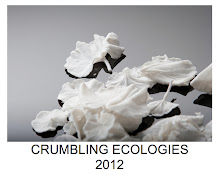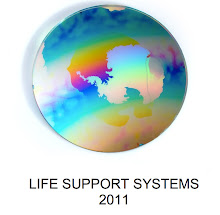Life Support Systems - Installation at Museum of Contemporary Art Taipei, Wonderland 2012
Glass
3 x Height 90cmx Length 90cmx Width 30cm
Glass
3 x Height 90cmx Length 90cmx Width 30cm
Life Support Systems uses NASA’s space suit
helmet glass to create a series of three atmospheric
weather maps charting shifting weather conditions in the atmosphere over
Antarctica that have global implications. The maps are hung sequentially and
read from left to right. The unfolding narrative of shifting weather is
described in short texts below each work that evolve from history of monitoring
Earth’s atmosphere to today’s attitudes towards Climate Change: the forecast
for tomorrow. The aim of the series was to examine
how the forecast for tomorrow’s weather is reliant on our perception of our
environment today. The work does this by being fabricated from a material that was
originally used as a part of the life support system of a space suit and
drawing a parallel with its natural counterpart, the Ozone Layer.
Visually we first
became aware of the role the Ozone Layer plays in sustaining our environment in
the 1950’s Space Race’s iconographic images of the Earth. In these dazzling
images Astronauts floated above the Earth tethered to spaceships, the only
thing keeping them alive was the fragile life support system of their space
suit. One of the most prominent features of the space suit was the luminescent
dichroic glass visor that aesthetically resembled a giant mirror or ‘all seeing
eye’. This lens reflected the first view of the Earth as a tiny
fragment in an ecosystem of universal proportions from which no part is immune
from the changes of its counterparts. This ignited global research to strive
for an expanded awareness of our environment. From this research the Ozone Hole
was discovered and today’s current ecological conundrum revealed.
Technical note: Dichroic Glass was originally engineered for the visor of space suit helmets in the 1950’s, it has been customised in these works by Jasmine Targett and manufactured by CBS Glass Industries USA.
Life Support Systems: from Earth
From Earth the immanent threat of the ecological conundrum evades sensory perception. On a clear morning the sky appears blue, the atmosphere majestic. The unseen danger that looms above appears only as a flickering to those aware of the impending situation.
Life Support Systems: Ether
On the 24th of September 2006 the largest observed ozone hole was monitored in Earth’s Atmosphere. At 29.5 million km2 it more than doubled the area of Antarctica, 14 million km2 including ice.
Ether makes visible the thin reflective film of ozone protecting Earth, and outlines the inconceivable enormity of the unstable area. Like a bubble whose structural integrity has been compromised, the Earth’s life support system is tethered to an ecosystem of universal proportions from which no part is immune from the changes of its counterparts.
Life Support Systems: View from the Tomorrow
View from Tomorrow maps the forecast for changing atmospheric conditions over Antarctica as the ozone hole closes and toxic greenhouse gases are trapped. At sunset the sky is set a blaze with luminous artificial colours caused by pollution in the atmosphere, a beautiful decay predicted to intensify in years to come.
From the outside looking in it is apparent that perception is reliant on perspective. Vast amounts of scientific data produced to comprehend changing environmental conditions challenge the way we make sense of the world. The forecast for tomorrow is reliant on our perception of today.
Exhibition images from Making Sense at Craft Victoria, 2011.
A City of Melbourne Arts Grant has funded the creation of this work. The series will be exhibited in Wonderland at the Museum of Contemporary Art Taipei, Feb 2012.














